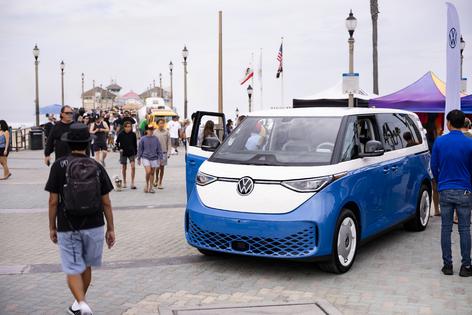Eric's Autos: 2025 Volkswagen ID. Buzz
The Volkswagen ID. Buzz is interesting in that it looks like the old VW Microbus of the '60s and '70s but is nothing like it.
This has its good -- and bad -- points.
What It Is
The ID. Buzz is a kind of visual reincarnation of the Microbus of the '60s and '70s that's entirely different in just about every other way. It has working heat and AC, for openers. And it does not take 60 seconds to get to 60 mph. It has a battery pack and powerful electric motor(s) rather than a struggling air-cooled four in the back. It also weighs nearly three times as much as an old Microbus -- and costs about three times as much too.
The base Pro S trim, which is rear-drive and has a 282 horsepower all-electric drivetrain powering the rear wheels (the one functional commonality it shares with the original, Beetle-based Microbus) comes standard with three rows of seats, standard dual-sliding doors, a nine-speaker audio system, heated steering wheel and a 12.9-inch touch screen stickers for $59,995.
The Pro S trim ($63,495) adds a better 13-speaker sound system, hands-free operation for the side doors and liftgate, a surround-view camera and the option to upgrade to a more powerful (335 horsepower) dual-motor system that VW markets as 4Motion, which is bundled with other upgrades that include a heated windshield and second-row captain's chairs.
A top-the-line 1st Edition lists for $65,495 with the rear-drive electric-vehicle drivetrain (and 282 horsepower) or $69,995 with the dual motor setup and 4Motion all-wheel drive. The 1st Edition gets a unique-to-this trim two-tone paint job, roof rack and panorama glass sunroof.
VW says the Buzz has a best-case range of about 234 miles on a fully charged battery.
What's New for 2025
The ID. Buzz is VW's latest model -- based (at least insofar as how it looks) on the classic VW Microbus.
What's Good
-- As distinctive-looking as the original Microbus, which is a huge departure from everything else (that looks pretty much like everything else).
-- Doesn't take 60 seconds to get to 60 mph.
-- Has cold AC and heat that works.
What's Not So Good
-- Modest range is a problem compounded by the time it takes to recharge.
-- VW charges almost $700 extra for a home-charge cord.
-- Front quarter windows don't open, so you pretty much have to use the AC to stay cool -- which saps range. Ditto using the heat.
Under the Hood
The ID. Buzz doesn't have a hood -- another point in common with the classic Microbus. The latter had its engine mounted in the rear, over the rear wheels. The ID. Buzz has an electric motor mounted back there, directly driving the rear wheels (the Microbus came standard with a four-speed manual transaxle).
This motor makes about four times as much power (282 horsepower) as the air-cooled four-cylinder engine that powered the Microbus made -- and it's a necessary thing, given the ID. Buzz weighs just shy of three tons (5,968 pounds), which is just shy of three times as much as the classic Microbus weighed (about 2,500 pounds). So even though the Buzz is extremely heavy -- chiefly due to the weight of the massive energy storage device -- the battery pack -- it can still get to 60 mph in just over seven seconds.
With its optional dual-motor setup, the 0-60 mph time falls to about six seconds. That's very quick, especially for something that was designed to recall the Microbus, which was infamous for being slow.
On the other hand, driving range with either the single- or dual-motor setup is about 234 miles, which isn't as far as the old Microbus could go on a full tank of gas. The more relevant thing, though, is arguably how long it takes the Buzz (like all EVs) to recharge. Some say the 15-20-minute wait for a partial charge at a public fast charger isn't very long to wait.
But it can ruin your plans if you don't plan for it.
On the Road
The Buzz is quick. It easily keeps pace with traffic, something the classic Microbus struggled to do. It is also quiet and rides like a Cadillac, two other attributes the classic Microbus lacked. Also, the AC blows ice cold, and the heat is both hot and doesn't include fumes.
The Buzz does not feel fragile and out of its depth on any road where traffic is moving faster than 45 mph.
The chief downside is that the Buzz hasn't got much driving range. The touted 234 miles isn't much to begin with -- equivalent to about half a tank of gas, in terms of the range of just about any current car or (for a closer comparison) minivans, which, if you take away the retro look, is what the Buzz is.
And 234 miles is best case.
It assumes light-load conditions, so not uphill and not driving fast and definitely not using the AC full tilt on a hot day (or the heat on a cold day). All those things can greatly reduce the actual driving range you will get. If there's say a 20% difference between the best case and the worst case, you'd only have about 188 miles of range, and you'll probably want to always leave at least 20 miles in reserve because it is common to find that the public fast charger you were planning to use isn't working, and then you'll have to drive to the next one.
The iffy nature of EV charging infrastructure is arguably more the problem than the relatively short range of most EVs. If people could safely assume that there are fast charger kiosks pretty much everywhere and that they'd be working, then range anxiety wouldn't be as much a thing.
The VW's range is actually fairly impressive given its weight. This thing is only slightly lighter than a Ram 2500 dualie pickup. The old Microbus, in contrast, was light enough that a couple of hippies could push it down the road.
At the Curb
The Buzz's looks have created a buzz. It is one of the few new vehicles that doesn't look like all the other new vehicles. It draws lots of attention -- almost all of it positive. It is also a lot roomier inside than it was in the old Microbus, which was cramped as well as hot in summer and cold in winter due to not having AC -- and heat that didn't do that.
The dual sliding doors have mini windows that can be opened, but there are no window switches for the driver to open them with. VW offers an optional storage bin system for the rear cargo area that's helpful for organizing (and hiding from view) small items. The main instrument display is small and not distracting; the large secondary touch screen can be aggravating to use, and you pretty much have to use it to operate the sound system and the climate controls.
The Rest
In addition to buying the extra-cost home charging cord, be aware that you will probably need to have an electrician come out to your house to wire up a dedicated 240-volt outlet (and circuit) somewhere in your garage, if you want to be able to home-charge faster than overnight. This is a cost worth the expense, though -- and not only because it enables you to charge at home in a reasonable amount of time. It is generally much less expensive to recharge an EV at home than it is at commercial fast charger kiosks, where it can be nearly as expensive to charge up as it costs to gas up.
The Bottom Line
Nostalgia is always fun. But how many can afford it?
========
Eric's latest book, "Doomed: Good Cars Gone Wrong!" will be available soon. To find out more about Eric and read his past columns, please visit the Creators Syndicate webpage at www.creators.com.
Copyright 2025 Creators Syndicate, Inc.








Comments